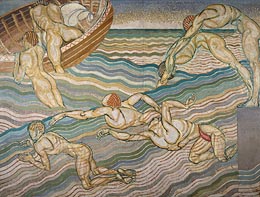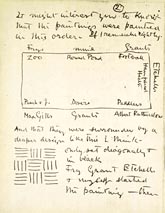|
Painting together |
House decoration |
The Hogarth Press |
Stage designs |
Berwick Church decorations
Borough Polytechnic murals |
The Cunard affair
The Borough Polytechnic murals: Grant and Fry

In 1911 Roger Fry was invited to organise the decoration of the dining room at Borough Polytechnic in South London
(now South Bank University).
He persuaded Duncan Grant and two other young artists, Bernard Adeney and
Frederick Etchells, to work alongside him and create designs illustrating the theme of 'London on Holiday'.
Artists Macdonald Gill and William Rutherston were later also recruited because of the size of the space and limited timescale allocated for the project (the students' summer vacation).
As the project had a small budget of £100, the murals were painted in oil paint on panels of canvas attached to the wall instead of more expensive tempera paint applied directly
onto the plaster walls.
Fry's planning was rather informal. His selection of artists was based on trust and availability, rather than any shared style.
He hoped that a sense of unity would be created by the theme, a limited palette, and agreement to paint using mosaic-inspired dark outlines. |

Duncan Grant, Bathing, 1911
© Tate Archive, 2003 |

Bernard Adeney letter from 1953
© Richard Adeney |
In a letter written nearly half a century later, Bernard Adeney provides an account of the painting of the murals.
This page from the letter includes a plan of the dining hall showing the location of the murals within the room.
Although Duncan Grant's two pictures Bathing and Football, reflected his interest in both early Italian art and Byzantine mosaics, the paintings look
strikingly modern.
This is not solely due to the contemporary subject matter (bathers swimming in the Serpentine and footballers in Hyde Park), but also Grant's interpretation of earlier styles,
influenced perhaps by the contemporary French art of the Post-Impressionists that Roger Fry had introduced to him.
The figures in the paintings are not carefully delineated individuals but rather provide an impression of the acts of swimming or of playing football.
| 'Do not ask yourself, as you look at it, whether it is at all like the Serpentine or any bathers in it that you have ever seen',
a reviewer writing in The Times advises his readers,
'It is not, and is not meant to be. But, if you will not demand any illusion, you will find that it gives you an extraordinarily keen sense of the pleasure of swimming.
In fact it acts on you like poetry or music.
Mr Grant has used all his remarkable powers of draughtsmanship to represent the act of swimming rather than any individual swimmers.' |

The Times, 9 September 1911 |
|
The murals received much press coverage.
Most previous public mural schemes had drawn from historic, symbolic or allegorical content with the aim of providing moralistic or patriotic guidance for the viewing public.
The Borough Polytechnic murals with their light-hearted celebration of contemporary life showed no such concerns and provoked some criticism, one reviewer feared that they
would have a corrupting effect on the polytechnic's working-class students!
However there were many positive responses as well, particularly to Grant's paintings and those of Etchells, whose painting style was closest to Grant's, and who chose as his
subject people enjoying an afternoon on Hampstead Heath.
The project did much to further Grant's career and brought him to the attention of the public, as well as encouraging his lifelong interest in working on large decorative schemes.
|
